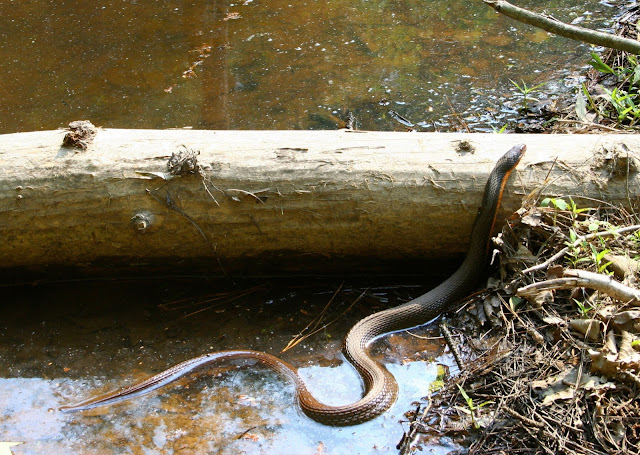A quick hike before Hunter's soccer match in Chapel Hill yields an interesting encounter with a languidly lounging reptilian. Distracted by the abundant painted buckeye blossoms, walker one and walker two nearly tread on the unmoving and unmoved sunbather, until Jay casually asks if we saw the snake.
In spite of its relatively large girth and nearly three foot length, this snake's dull brown dorsum and utter stillness would have allowed it to go completely unnoticed by the hike's blind-eyed leaders. But thanks to Jay's young and curious eyes, we recognized our friend the redbelly water snake, lying in the leaves just a few feet from the trailside stream.
A closer look reveals the reason for its languor, and the unusually dull dorsum...the snake appears to be molting, or shedding its skin. Turns out the hikers aren't the only blind-eyed creatures on the trail today! As you can see from the picture above, the specialized "eye cap" or ocular scale which covers the eye of snakes, has loosened and is beginning to peel away, along with the rest of the skin on its head, rendering this individual temporarily blind. We quietly left this fellow to finish shucking his worn-out dermis, and later located a few pictures of his Lee county kin with a bit fresher skin.
The redbelly water snake is North Carolina's version of the plainbelly water snake found throughout the southern U.S. In other regions, the belly is a pale yellow or almost white, but consistently lacks any markings, hence plainbelly.
This one was encountered in late April last year in Lee County's San-Lee Park, and it took a moment to calmly check us out before returning to the waters of the nearby lake. These snakes are not aggressive, but if handled or harassed, they will strike and/or bite repeatedly and release an extremely foul-smelling musk to discourage predators.
After testing the air with its tongue and apparently finding our presence distasteful, this impressive specimen casually moved on to a better spot at the water's edge.






No comments:
Post a Comment